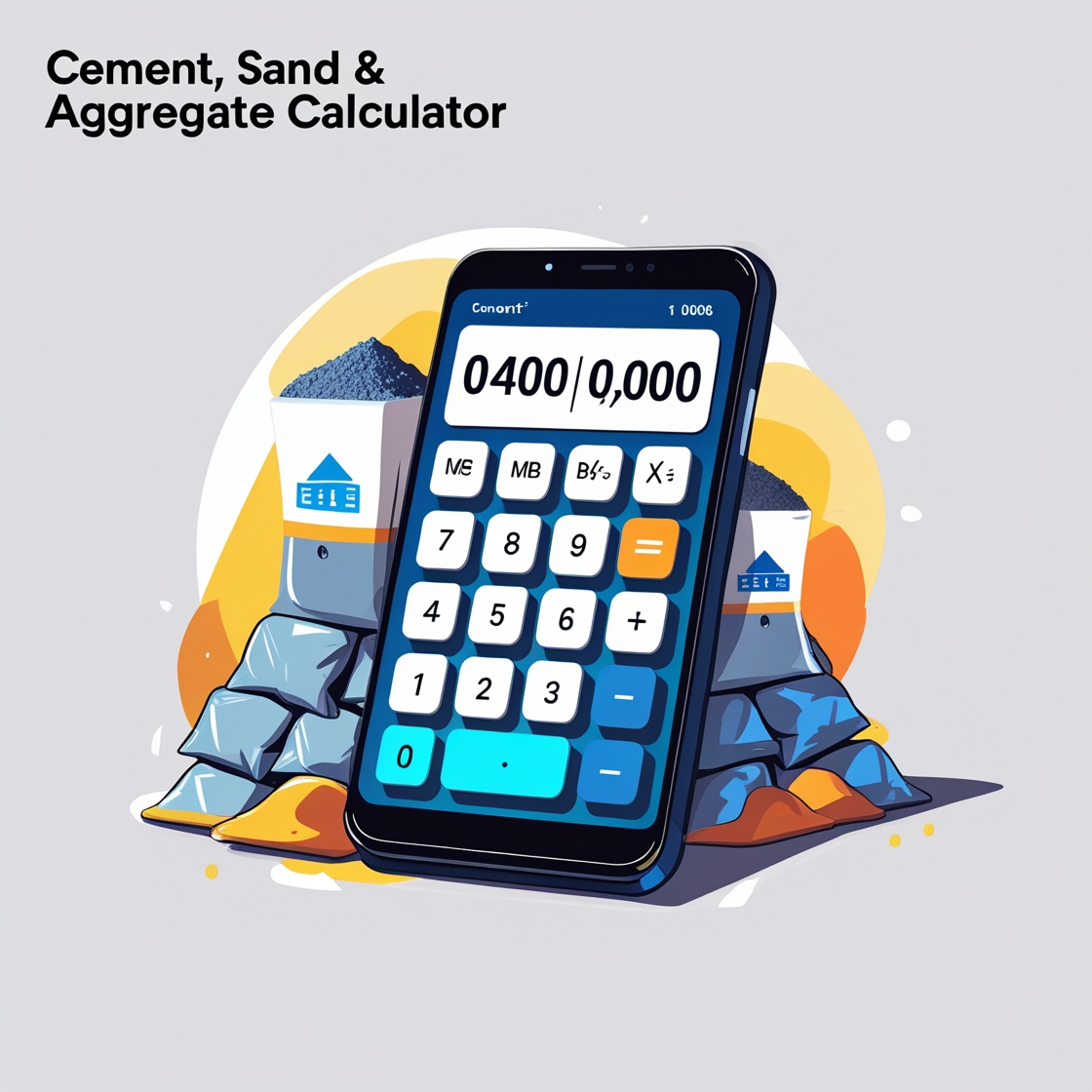
Concrete Quantity (cubic feet)
Concrete Quantity (cubic metres)
| Output | Unit | ||
|---|---|---|---|
| Cement | 0.00 | 0.00 | bags |
| Sand | 0.00 | 0.00 | cum |
| Aggregates | 0.00 | 0.00 | cum |
When it comes to constructing a concrete slab, accurate estimation of materials like cement, sand, and aggregates is crucial. Whether you’re a DIY enthusiast or a professional builder, using a Cement, Sand & Aggregate Calculator can save you time, money, and effort. In this blog, we’ll explore how to calculate the quantity of materials required for a concrete slab and why using a calculator is essential for efficient construction.
Why Use a Cement, Sand & Aggregate Calculator?
Calculating the exact amount of cement, sand, and aggregates needed for a concrete slab can be challenging, especially for large projects. Manual calculations are prone to errors, which can lead to material wastage or shortages. A Concrete Slab Calculator simplifies this process by providing precise measurements based on your inputs. Here’s why it’s a must-have tool:
- Accuracy: Ensures the right amount of materials are used.
- Cost-Effective: Prevents over-ordering or under-ordering of materials.
- Time-Saving: Eliminates the need for complex manual calculations.
- Sustainability: Reduces material wastage, promoting eco-friendly construction.
How to Calculate Cement, Sand, and Aggregates for a Concrete Slab
To calculate the materials required for a concrete slab, you need to know the following:
- Concrete Ratio: The proportion of cement, sand, and aggregates (e.g., 1:2:4).
- Slab Size: The area of the slab in square feet or square meters.
- Slab Thickness: The thickness of the slab in inches or millimeters.
Step-by-Step Calculation
- Determine the Volume of Concrete Required:
- Volume = Slab Size (Area) × Slab Thickness
- Convert the thickness to feet (if in inches) by dividing by 12.
Example:
- Slab Size = 500 sq. ft.
- Slab Thickness = 6 inches (0.5 feet)
- Volume = 500 × 0.5 = 250 cubic feet.
- Convert Volume to Cubic Meters (if needed):
- 1 cubic meter = 35.3147 cubic feet.
- Volume in cubic meters = 250 / 35.3147 ≈ 7.08 cubic meters.
- Calculate the Quantity of Cement, Sand, and Aggregates:
- Use the concrete ratio to determine the amount of each material.
- For example, a 1:2:4 ratio means 1 part cement, 2 parts sand, and 4 parts aggregates.
Let’s break it down:
- Total parts = 1 + 2 + 4 = 7 parts.
- Cement required = (1/7) × Total Volume.
- Sand required = (2/7) × Total Volume.
- Aggregates required = (4/7) × Total Volume.
Example:
- Cement = (1/7) × 7.08 ≈ 1.01 cubic meters.
- Sand = (2/7) × 7.08 ≈ 2.02 cubic meters.
- Aggregates = (4/7) × 7.08 ≈ 4.04 cubic meters.
- Convert to Bags of Cement:
- 1 bag of cement = 0.035 cubic meters.
- Number of bags = Cement Volume / 0.035.
- Example: 1.01 / 0.035 ≈ 29 bags of cement.
Benefits of Using a Concrete Slab Calculator
A Concrete Slab Calculator automates these calculations, ensuring accuracy and efficiency. Here’s how it works:
- Input Slab Dimensions: Enter the slab size and thickness.
- Select Concrete Ratio: Choose the desired ratio (e.g., 1:2:4).
- Get Instant Results: The calculator provides the exact quantity of cement, sand, and aggregates required.
Example Output from a Calculator:
- Concrete Quantity: 250 cubic feet (7.08 cubic meters).
- Cement: 29 bags.
- Sand: 2.02 cubic meters.
- Aggregates: 4.04 cubic meters.
Tips for Efficient Concrete Slab Construction
- Choose the Right Concrete Ratio:
- For slabs, a 1:2:4 ratio is commonly used for general purposes.
- For high-strength slabs, use a 1:1.5:3 ratio.
- Use Quality Materials:
- Ensure the cement, sand, and aggregates are of good quality to achieve a durable slab.
- Compact the Concrete Properly:
- Use a vibrator to remove air pockets and ensure even distribution.
- Cure the Slab:
- Keep the slab moist for at least 7 days to prevent cracking.
- Double-Check Calculations:
- Use a Cement, Sand & Aggregate Calculator to verify your measurements.
Why Accurate Calculations Matter
Incorrect calculations can lead to:
- Material Wastage: Excess materials increase costs.
- Structural Weakness: Insufficient materials compromise the slab’s strength.
- Project Delays: Running out of materials can halt construction.
By using a Concrete Slab Calculator, you can avoid these issues and ensure a smooth construction process.
Conclusion
Calculating the right amount of cement, sand, and aggregates for a concrete slab is essential for any construction project. A Cement, Sand & Aggregate Calculator simplifies this process, providing accurate and reliable results. Whether you’re building a small patio or a large foundation, this tool ensures efficiency, cost-effectiveness, and sustainability.
So, the next time you plan a concrete slab project, don’t leave it to guesswork. Use a calculator and build with confidence!


Leave a Reply